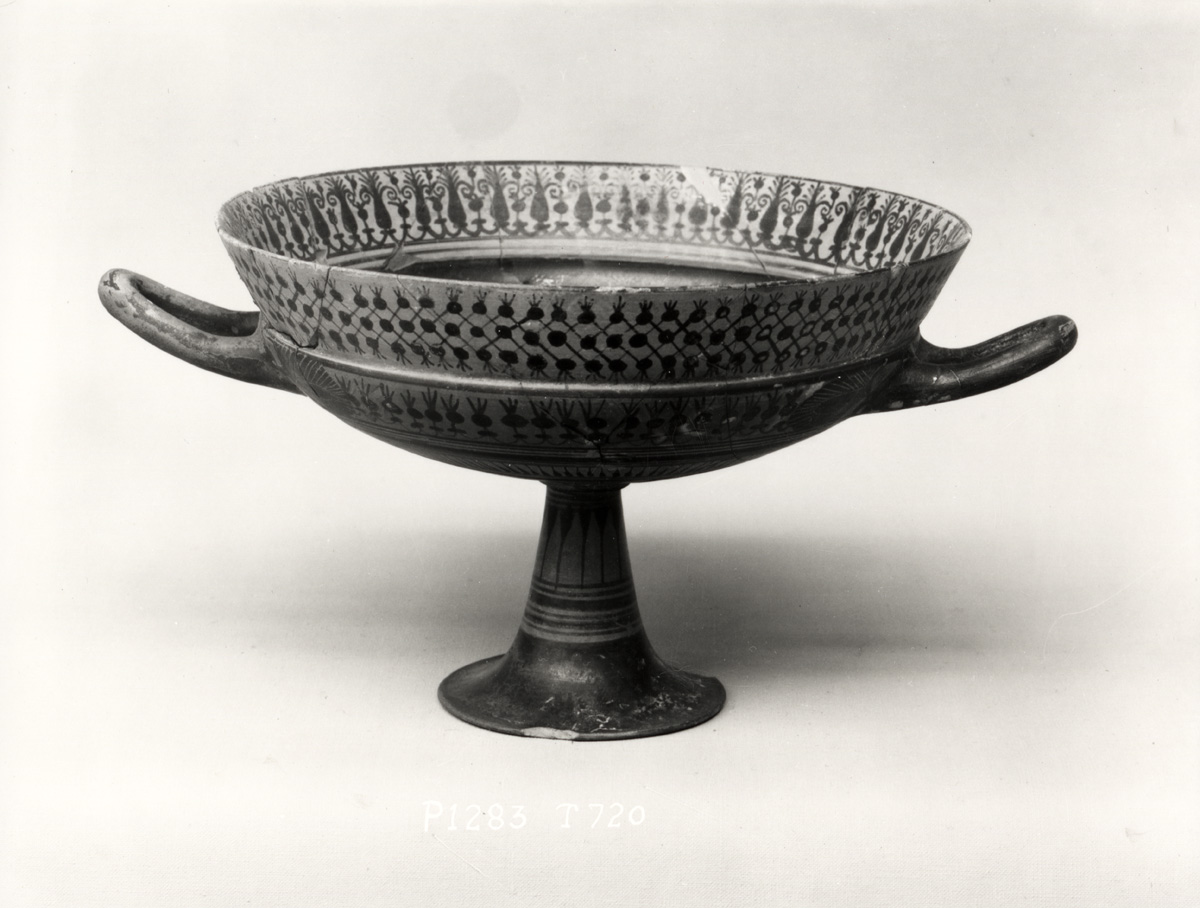-
 Lakonian Krater Fragment
Lakonian Krater FragmentM10 Cat. Lak 9
Pottery
Ceramic
Ca. 575-550 BC (?) (Lydian)
Fragment of neck and shoulder, evidently belonging to a volute krater. On shoulder, handle scar. Clay fine, dull reddish brown (5 YR 6/3-6/4, "light reddish brown") at exterior changing to gray (slightly darker than 7.5 Y R 5/2, "brown") at inner edg...
-
 Lakonian Krater Fragment
Lakonian Krater FragmentM10 Cat. Lak 10
Pottery
Ceramic
Ca. 575-550 BC (?) (Lydian)
Shoulder fragment with pattern ornament with lower part of neck and part of handle, perhaps belonging to a volute krater. Clay gray-tan, non-micaceous, hard. Decoration in cream slip, black glaze, red paint.
Interior: black glaze except for narrow res...
-
 Lakonian Krater Fragment
Lakonian Krater FragmentM10 Cat. Lak 11
Pottery
Ceramic
Ca. 580-540 BC (Lydian)
Rim-neck fragments including handle-plate (two joining fragments making one-third to one-fourth of the rim and two small rim fragments) of a stirrup krater. Clay gray pink-tan (5 Y R 5/4) at outside blending to gray-brown (10 Y R 5/2) at core; fine; ...
-
 Lakonian Krater Fragment
Lakonian Krater FragmentM10 Cat. Lak 12
Pottery
Ceramic
Ca. 580-540 BC (Lydian)
Small rim fragment. Clay grayish (10 YR 5/3). Decoration in cream slip (worn) and black (N3/) glaze.
Interior of neck, on inner top surface of rim, and exterior of neck, glaze. On outer top surface of rim, slip. On side of rim, slip, over which maeand...
-
 Lakonian Krater Fragment
Lakonian Krater FragmentM10 Cat. Lak 13
Pottery
Ceramic
Ca. 580-540 BC (Lydian)
Rim-neck fragment (including neck-shoulder juncture). Clay gray (10YR 5/1-5/2), hard. Decoration in cream (2.5Y6/2-5/2) slip, black (N2/)glaze.
Interior, on top surface of rim and on exterior of neck, glaze. On side of rim, slip, over which maeander h...
-
 Lakonian Krater Fragment
Lakonian Krater FragmentM10 Cat. Lak 14
Pottery
Ceramic
Ca. 580-540 BC (Lydian)
Rim-neck fragment. Clay gray (10 Y R 5/2). Decoration in cream (2.5 Y 7/2-6/2) slip and black (N3/) glaze. Slip mostly worn away.
Interior of neck, on inner top surface of rim, on exterior of neck, glaze. On outer top surface of rim, slip. On side of ...
-
 Lakonian Krater Fragment
Lakonian Krater FragmentM10 Cat. Lak 15
Pottery
Ceramic
Ca. 580-540 BC (Lydian)
Rim-neck fragment. Decoration in cream slip and black glaze. On side of rim, slip, over which maeander hooks between rows of dots (Stibbe Type 3) in glaze.
-
 Lakonian Black-figure Cup
Lakonian Black-figure CupM10 Cat. Lak App. 1
Pottery
Ceramic
Ca. 565-525 BC (?) (Lydian)
Complete except for small parts of bowl, rim, foot plate. In the center of the tondo, slight depression. At the juncture of foot and bowl, fillet. Decoration on interior and exterior in cream (close to 10 Y R 7/2, "light gray") slip, dilute and full-...
-
 Attic Black Figure Skyphos Fragments
Attic Black Figure Skyphos FragmentsM10 Cat. Att App. 16-17
Pottery
Ceramic
Ca. 500-475 BC (Lydian)
Four joining fragments of wall (only one illustrated). Dancing woman among vines with part of a stylized palmette at left; black glaze above figured frieze and a black band at bottom.